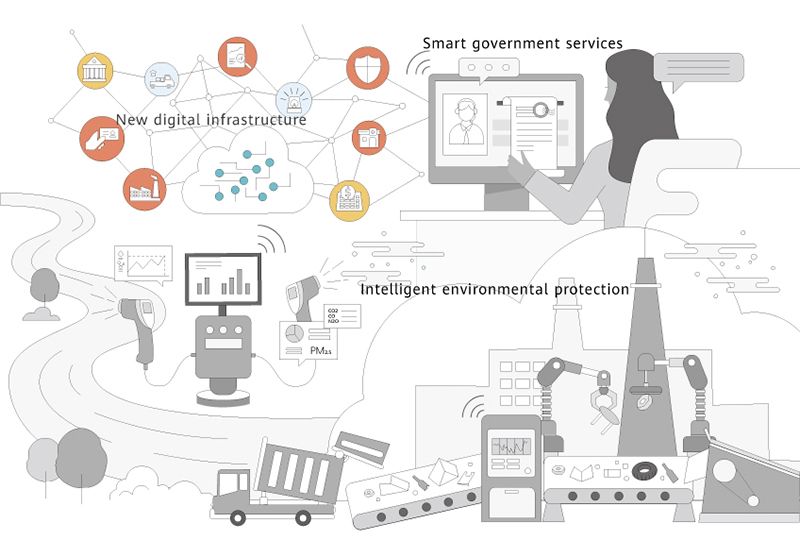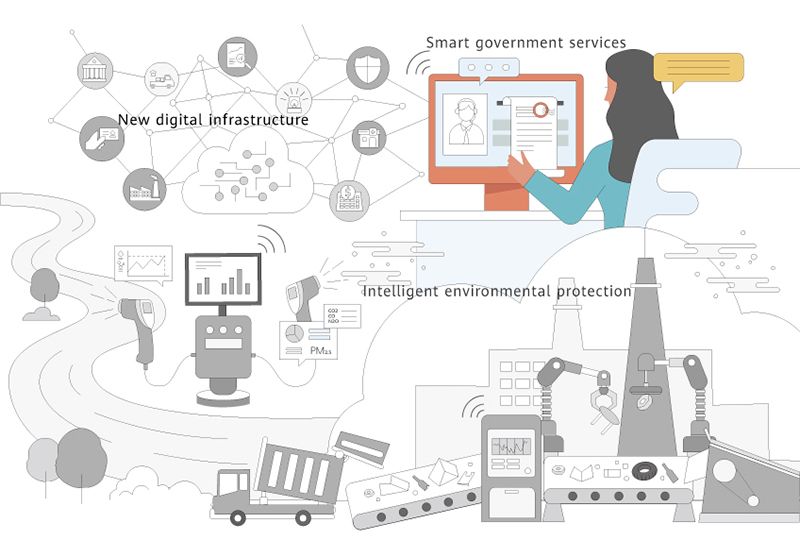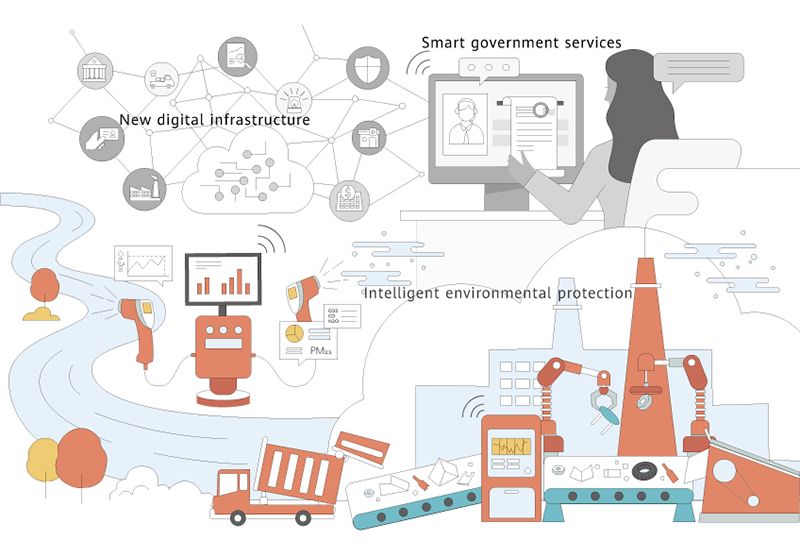New Digital Infrastructure Makes Cities More Human and Livable
Predictions
Directions for Exploration

New digital infrastructure is the engine of digital cities
Snapshot from the future: Intelligent and digital city upgrade underpinned by intelligent computing centers
As a key pillar of urban information infrastructure, intelligent computing centers are essential to satisfy the fast-growing demand for AI computing power in cities. They play an important role in promoting AI industrialization, industry intelligence, intelligent governance, and industry clusters. They are also key to driving comprehensive digital city transformation, optimizing industry structures, and improving the competitiveness of individual cities in the digital economy era.
Intelligent computing centers will support cross-industry collaboration by providing diversified computing power and integrated services. They will also consume less energy and make computing resources more affordable and accessible. Intelligent computing centers will also be connected to AI computing networks. Computing infrastructure, especially intelligent computing centers and computing networks, can effectively promote AI industrialization and industry intelligence, and serve as the foundation for intelligent cities that underpin the digital economy. Intelligent computing centers provide cost-effective, affordable, and secure computing resources that will make AI computing power as easily available to governments, enterprises, and the public as water, electricity, gas, and other urban public utilities.
Snapshot from the future: All-optical, 10-gigabit cities
Major cities around the world are now racing to release their own 10-gigabit action plans, with over 20 provinces and cities having already released one. Beijing has announced its Optical Network Capital, 10-Gigabit City Action Plan (2023–2025) while Shanghai has unveiled its Action Plan for Further Promoting New Infrastructure Construction (2023–2026) to connect the whole city with 10-gigabit 5G-A networks and 10-gigabit optical networks. Qinghai has also released Guidelines on Dual 10 Gigabit (5G-A & F5G-A) Industry Development and Application Innovation. Saudi Arabia has also unveiled The 10 Gbps Society white paper which echoes the Middle East's vision for 10-gigabit experience.
The future architecture of an all-optical city will consist of four parts:
- All-optical access: All network connections will be optical, including home, building, enterprise, and 5G base station connections. All-optical transmission networks will be extended into edge environments like large enterprises, buildings, and 5G base stations. 10-gigabit access networks will enable digital transformation across industries, support access to cloud and computing networks within one millisecond, and drive F5G-A application in diverse scenarios as well as 5G adoption in business settings. By 2030, optical transport networks will cover all government agencies, financial institutions, key universities and scientific research institutions, large hospitals, large industrial enterprises, as well as development zones and industrial parks above the county level.
- All-optical anchors: Connections originating in home broadband, enterprise broadband, 5G networks, and data centers will be routed and transmitted through all-optical networks. All-optical anchors will support multiple technologies, enable service-based traffic steering, and provide one-hop connections to cloud and computing networks. By 2030, every 10,000 people will have four all-optical OTN anchors, and 25% of these anchors will deliver 100G services.
- All-optical bearing: Urban optical networks support one-hop access to services. All-optical cross-connect, optical-electrical hybrid automatically switched optical network (ASON), and other technologies will be used to build multi-layer optical networks that support one-hop access to services, highly reliable networking, high-speed inter-cloud transmission, and high synergy between optical and computing networks. More than 50% of data centers will be connected with each other through optical networks, with single-wavelength bandwidth higher than 400 Gbit/s. Mesh fiber networks can deliver 99.9999% reliability thanks to their ability to withstand two or more cut fibers, without services being interrupted. All data center networks will adopt a hybrid optical-electrical design that uses all-optical switching technologies to connect switches and routers within individual data centers.
- Intelligent and automated O&M: Real-time sensing of network status with proactive, preventive O&M will support elastic network resources, and automated service provisioning, resource allocation, and O&M.

Smart government services make cities more human
Snapshot from the future: Proactive, precise, data-based government services
Machine recognition technology enables contactless services. Today, in most of China's developed provinces, residents no longer need to go to government service halls to access government services. Instead, they can now simply use their smartphones. Over the next decade, more and more intelligent digital government services will surface.
1. Digital identity authentication is expected to be widely adopted. The ID cards, drivers' licenses, social security cards, and bank cards that people carry at all times will be digitalized, creating a total addressable market for global electronic identity authentication services worth US$18 billion by 2027.
2. Digital credit will underpin and restructure many public service processes and the customer experience. It will be one of the founding technologies for digital government. Most residents are already familiar with some services like electronic library cards, social security cards, and car rental services that require a credit rating.
3. Universal access to one-stop, e-government services will soon be realized. In the future, all government services will be remotely accessible and government service halls may cease to exist.
Snapshot from the future: Urban data spaces that promote the circulation and unlock the value of data elements
Data has become the fifth key factor of production in addition to land, labor, capital, and technology. It has also become a new driver of the digital economy. Efforts should be made to accelerate data circulation and transactions, as this is crucial for unlocking the value and potential of data. By 2030, the global data transaction market is expected to reach US$301.1 billion, with China's market reaching CNY515.59 billion at a fast compound annual growth rate of about 20.3%.
Digital societies produce massive amounts of data and open up new spaces for urban data. The amount of data generated by cities is growing from terabytes to petabytes, and data is becoming the new oil for cities. Through urban data spaces and technologies, especially big data, blockchain, AI, privacy computing, and security and trustworthiness technologies, cities will be able to effectively process and analyze massive amounts of data, maximize the value of data elements, and use data to inform urban management and decision making. This means data has the potential to create greater economic and social value, and become a new driver of urban development.

Intelligent environmental protection for livable cities
Snapshot from the future: Automatic waste disposal for zero waste cities
With the help of AI, the entire waste management process in a future city, from collection and transportation to sorting and processing, will be automated and intelligent. Intelligent waste recycling bins, driverless garbage trucks, automated waste sorting robots, automated garbage recycling devices, and other innovative applications will emerge one after another. Hopefully, this will help to make more and more zero waste cities possible.
Snapshot from the future: Optical detection making water sources safer
Optical technologies can also be further integrated with analytics from the IoT, AI, and cloud computing. Sensors for water quality and deep data analytics will move us closer to 24/7, efficient, real-time, automated, intelligent water quality monitoring and enable faster warnings in cases of water contamination.
Snapshot from the future: Real-time AI air quality monitoring
Most cities will likely soon opt to deploy cost-effective and reliable air quality sensors and build new monitoring networks. This will allow them to monitor air quality and weather across the entire city and take targeted measures to improve air quality and the urban environment. One company has developed a highly-integrated, real-time air monitoring system that uses integrated sensors and software to monitor the concentrations of environmental pollutants in urban environments, such as PM2.5, PM10, CO, NOx, SOx, and O3, as well as other environmental parameters like noise, temperature, humidity, air pressure, rainfall, and flooding. The system's data is wirelessly transmitted in real time to a cloud platform that in turn provides a real-time visual dashboard for effective management of the overall environment in key areas of the city.
More Outlooks













